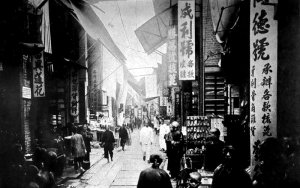![]() The Pacific War Online Encyclopedia
The Pacific War Online Encyclopedia
|
| Previous: Canopus, U.S. Submarine Tender | Table of Contents | Next: Canton Island |

Department of Commerce. Via Wikimedia Commons
Canton (Guangzhou; 113.239E 23.125N), located on the estuary of the Pearl River, is one of the most important and most ancient port cities of China. Arab merchants were trading through this port as early as the 2nd century, and the Portuguese first arrived in 1516. Canton was the first of the treaty ports, and maintained a monopoly on the South China trade until the rise of Hong Kong ca. 1880. It was the terminus of the southern China rail system after 1936 and a center of river traffic, with a population of about a million and a half persons. The various waterways of the city were crowded with river vessels housing tens of thousands more. Vessels of up to 2000 tons could navigate 200 miles upstream to Wuchow. Because of silting, large oceangoing vessels docked at Whampoa, 10 miles downstream from Canton.
The city was repeatedly bombed, beginning on 2 February 1938, though the Japanese were careful to avoid the International Settlement at Shameen. The city was taken by 21 Army, which landed
at Bias Bay east of Hong Kong on 12 October 1938 and rapidly advanced
to Canton against negligible opposition. Meanwhile Japanese aircraft destroyed the Chinese river communications, sinking seven gunboats and four PT boats. The Chinese had counted on the British
at Hong Kong to deter a Japanese move against Canton, but the landings
well away from the British stronghold caught the Chinese by surprise.
The timing, just two weeks after the Munich crisis, took advantage of
the perception of Western weakness. The Japanese entered Canton on 21
October, after the defending 12 Army Group had abandoned the city without a fight, and captured the Humen fortress on the Pearl River from the landward side the next day.
At the time war broke out, Canton Special Base Force
garrisoned the city, and the airfield
at Tien Flo based 44 Air Regiment with 24 Ki-51 Sonia and 11 C5M Babs;
45 AIr Regiment with 36 Ki-36 Ida; 47 Squadron with 9
preproduction Ki-61 Tony; and 82 Light Squadron with 12 Ki-48 Lily.
| 21 Army (Mikio) |
About 70,000 men |
|
| |
11 Division |
|
| 18 Division |
||
| 104 Division |
||
| 12 Army Group (Yu) |
About 55,000 men |
|
| |
62 Army |
|
| 63 Army |
||
| 65 Army |
||
References
Dorn (1974)
The Pacific War Online Encyclopedia © 2007-2008, 2010, 2015 by Kent G. Budge. Index